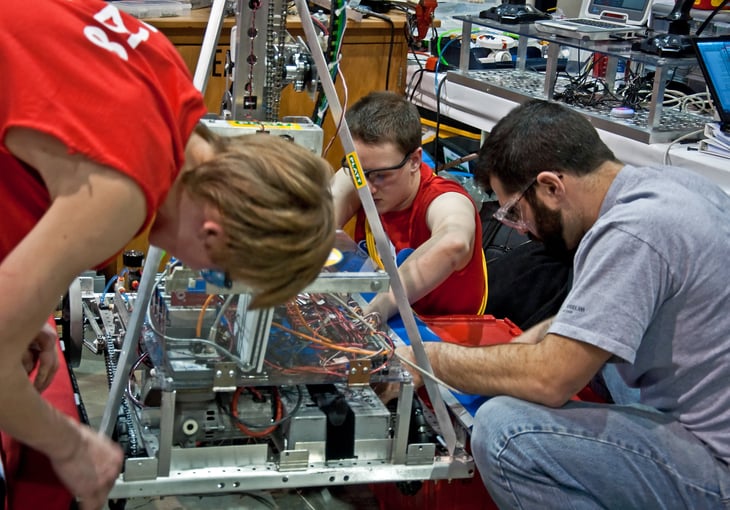
Maybe the famed three R’s of education — reading, writing and arithmetic — need to add a fourth R, raises. Teachers in districts across the country have made the news over the past year as they held rallies and, in some cities, went on strike to improve pay and school funding.
And for good reason: Research gathered this year by Governing Magazine shows that many of the very states where teachers are protesting are places where the difference between teachers’ pay and that of similarly educated private-sector workers is the greatest.
While the private-sector economy has gained momentum in recent years, teacher salaries haven’t kept up with inflation, according to this research, which compared average salary estimates for elementary and secondary school teachers in 2016 compiled by the National Education Association with U.S. Census data on the average salary nationally for full-time private-sector workers.
Few teachers go into education for the monetary rewards, but, as the study shows, choosing a teaching career is much more rewarding in some states than in others. Here’s a look at how teacher pay compares with the private sector in all 50 states and the District of Columbia.
Note: The slides start at the state where teachers make the smallest percentage of private sector pay (No. 51) and move to the state with the largest percentage (No. 1).
51. Virginia

Average teacher salary: $49,690
Average full-time private-sector salary: $62,830
Teacher wages as a percentage of private-sector counterparts: 79 percent
Virginia teachers’ average pay was just 79 percent of their private-sector counterparts in 2016, creating the largest pay gap of any state, Governing Magazine found.
50. Washington

Average teacher salary: $53,701
Average full-time private-sector salary: $66,972
Teacher wages as a percentage of private-sector counterparts: 80 percent
In tech company-heavy Washington state, from 2010 to 2016, private-sector employees enjoyed wage increases that were 2.1 percent higher than education employees. By 2016, teachers’ average pay remained one of the lowest percentages of private sector salaries in the nation, at 80 percent. Teachers in some districts were fighting back. A strike in the state’s largest city of Seattle was avoided in 2018, but southwest Washington teachers did strike, affecting 80,000 students.
49. Colorado

Average teacher salary: $51,233
Average full-time private-sector salary: $61,403
Teacher wages as a percentage of private-sector counterparts: 83 percent
Colorado teachers struck for more than two weeks this past spring to protest poor pay, low state-wide education spending and purported mismanagement of the state teachers’ pension. The strike ended with an agreement for a 2 percent pay raise.
48. District of Columbia

NEA average teacher salary: $73,991
Average full-time private sector salary: $85,553
Teacher wages as a percent of their private-sector counterparts: 86 percent
In the District of Columbia, education salaries actually went up more than private-sector workers’, with teachers seeing a 6.8 percent average increase compared with a 4.8 percent bump in the private sector.
47. Arizona

Average teacher salary: $47,218
Average full-time private-sector salary: $54,431
Teacher wages as a percentage of private-sector counterparts: 87 percent
Arizona teachers went on a historic weeklong walkout this past spring, resulting in a 20 percent raise worth $644 million, according to the Phoenix New Times. That might change their ranking from two years before, in 2016, among states whose teachers had the lowest percentage of private-sector pay, at 87 percent.
46. Utah

Average teacher salary: $46,887
Average full-time private-sector salary: $53,946
Teacher wages as a percentage of private-sector counterparts: 87 percent
In Utah, education salaries went up 3.5 percent between 2010 and 2016, compared with a 9.9 percent jump in private-sector pay during the same period.
45. Oklahoma

Average teacher salary: $45,276
Average full-time private-sector salary: $51,959
Teacher wages as a percentage of private-sector counterparts: 87 percent
Oklahoma saw its first teachers’ strike since 1990 in April 2018, when teachers walked out to protest the deep cuts in education spending per student that have led to low pay, overcrowded classrooms and a fifth of districts being open just four days a week. After 10 days, the two sides reached an agreement to raise salaries and state education funding.
44. South Dakota

Average teacher salary: $42,025
Average full-time private-sector salary: $47,243
Teacher wages as a percentage of private-sector counterparts: 89 percent
South Dakota has one of the lowest costs of living in the nation. That’s perhaps reflected in the average teacher salary in that state of just over $42,000. By contrast, the average teacher salary in pricey New York state is nearly twice that.
43. North Carolina

Average teacher salary: $47,941
Average full-time private-sector salary: $53,789
Teacher wages as a percent of their private-sector counterparts: 89 percent
North Carolina teachers rallied at the state capital in May 2018 to protest low wages and decreased employee benefits. In September, a North Carolina middle-school teacher appeared on the cover of TIME Magazine under the headline, “I have 20 years of experience, but I can’t afford to fix my car, see a doctor for headaches, or save for my child’s future. I’m a teacher in America.”
42. Missouri

Average teacher salary: $47,959
Average full-time private-sector salary: $53,271
Teacher wages as a percentage of private-sector counterparts: 90 percent
In Missouri, teacher and private-sector salaries moved at about the same rate between 2010 and 2016, with teacher salaries increasing by 4.9 percent and private-sector pay climbing by 5.1 percent.
41. Kansas

Average teacher salary: $47,755
Average full-time private-sector salary: $52,976
Teacher wages as a percentage of private-sector counterparts: 90 percent
Education employees in Kansas saw their salary increases exceed the average for the private sector, with education salaries going up by 8.4 percent and private-sector pay going up by 5.4 percent between 2010 and 2016.
40. Texas

Average teacher salary: $51,890
Average full-time private-sector salary: $57,560
Teacher wages as a percentage of private-sector counterparts: 90 percent
When you compare education employee wages with just those private-sector workers who have college educations (as most teachers do), the gap becomes more obvious. College-educated private-sector workers in Texas make an average of $74,188 compared with just over $50,000 for education workers.
39. Minnesota

Average teacher salary: $56,913
Average full-time private-sector salary: $62,313
Teacher wages as a percentage of private-sector counterparts: 91 percent
In Minnesota, education employees and private-sector workers had similar-sized wage increases. From 2010 to 2016, teacher wages went up by 9.2 percent while private-sector wages increased 9.4 percent.
38. Florida

Average teacher salary: $46,612
Average full-time private-sector salary: $50,557
Teacher wages as a percentage of private-sector counterparts: 92 percent
In Florida, one of the states hit hardest by the housing market collapse, education salaries have only gone up by 2 percent, compared with an average 7 percent increase in the private sector.
37. New Hampshire

Average teacher salary: $56,616
Average full-time private-sector salary: $60,633
Teacher wages as a percentage of private-sector counterparts: 93 percent
In new Hampshire, there was only a 1 percent difference in salary growth for education employees and private-sector workers between 2010 and 2016, with private-sector employees slightly ahead.
36. Louisiana

Average teacher salary: $49,745
Average full-time private-sector salary: $52,972
Teacher wages as a percentage of private-sector counterparts: 94 percent
In Louisiana, education salaries actually rose more than private-sector wages from 2010 to 2016, but by just a slim margin as teachers got pay raises that were 0.4 percent more than their private-sector counterparts.
35. New Mexico

Average teacher salary: $47,163
Average full-time private-sector salary: $50,212
Teacher wages as a percentage of private-sector counterparts: 94 percent
Education wages and private-sector wages in New Mexico showed a similar increase over the period studied, moving up 4.5 percent for education workers and 5 percent in the private sector.
34. West Virginia

Average teacher salary: $45,622
Average full-time private-sector salary: $48,553
Teacher wages as a percentage of private-sector counterparts: 94 percent
West Virginia schools were closed for almost two weeks in early 2018 as teachers went on strike. In the end, Gov. James C. Justice signed a bill to give teachers and other state employees a 5 percent pay raise. West Virginia’s strike inspired other states to follow suit, including Arizona.
33. Georgia

Average teacher salary: $54,190
Average full-time private-sector salary: $57,078
Teacher wages as a percentage of private-sector counterparts: 95 percent
Private-sector wages increased 7.7 percent in Georgia between 2010 and 2016, while education pay moved up just 1.3 percent during that time.
32. North Dakota

Average teacher salary: $51,223
Average full-time private-sector salary: $53,697
Teacher wages as a percentage of private-sector counterparts: 95 percent
North Dakota education and private-sector salaries increased at about the same rate from 2010 to 2016, though private-sector employee wages rose 1.2 percent more.
31. Mississippi

Average teacher salary: $42,744
Average full-time private-sector salary: $44,260
Teacher wages as a percentage of private-sector counterparts: 97 percent
Mississippi has one of the lowest average teacher salaries in the nation: Teachers in New York state, for example, earn an average salary that’s more than $36,000 above those in the Magnolia State. The cost of living, of course, is lower in Mississippi.
30. Tennessee

Average teacher salary: $48,817
Average full-time private-sector salary: $50,173
Teacher wages as a percentage of private-sector counterparts: 97 percent
Education salaries moved up a tiny bit more than private-sector wages in Tennessee between 2010 and 2016 — a 4.7 percent increase compared with 3.2 percent.
29. Connecticut

Average teacher salary: $72,013
Average full-time private-sector salary: $73,416
Teacher wages as a percentage of private-sector counterparts: 98 percent
Connecticut teachers saw their average salary go up 9.3 percent between 2010 and 2016, compared with a private-sector bump of 7.1 percent.
28. South Carolina

Average teacher salary: $48,769
Average full-time private-sector salary: $49,549
Teacher wages as a percentage of private-sector counterparts: 98 percent
In South Carolina, private-sector and teacher salaries remain fairly close, but between 2010 and 2016, private-sector salaries in that state rose 6.7 percent compared with 3.7 percent for education employees.
27. Delaware

Average teacher salary: $59,960
Average full-time private-sector salary: $60,884
Teacher wages as a percentage of private-sector counterparts: 98 percent
In Delaware, salaries for education employees rose faster than private-sector wages between 2010 and 2016, with teachers seeing an average 5 percent increase compared with 1.9 percent in the private sector.
26. Idaho

Average teacher salary: $46,122
Average full-time private-sector salary: $46,802
Teacher wages as a percentage of private-sector counterparts: 99 percent
Idaho’s teachers saw relatively little wage growth during the studied period, Governing.com notes, with just a 0.6 percent bump for educators compared with an 8.8 percent average increase in the private sector.
25. Nebraska

Average teacher salary: $51,386
Average full-time private-sector salary: $51,977
Teacher wages as a percent of their private-sector counterparts: 99 percent
Nebraska was one of the states, along with Alaska, that saw school employees receive significant pay raises from 2010 to 2016. Governing.com notes that teachers in the Cornhusker State enjoyed a 15.8 percent salary increase, while private-sector salaries rose about 11.6 percent during that period.
24. Alabama

Average teacher salary: $48,518
Average full-time private-sector salary: $48,924
Teacher wages as a percentage of private-sector counterparts: 99 percent
In Alabama, the average teacher salary and average private-sector salary are just a few hundred dollars apart. They’re even growing roughly in tandem, with education salaries up 5.9 percent compared with private-sector salary up 6.5 percent from 2010 to 2016.
23. Illinois

Average teacher salary: $63,475
Average full-time private-sector salary: $63,997
Teacher wages as a percentage of private-sector counterparts: 99 percent
The average teacher salary in Illinois is close to that of private-sector workers, and raises between 2010 and 2016 favored teachers, whose salaries rose 11.5 percent compared with 5.7 percent in the private sector.
22. New Jersey

Average teacher salary: $69,330
Average full-time private-sector salary: $69,760
Teacher wages as a percent of their private-sector counterparts: 99 percent
Public school teacher pay rose 9.7 percent in New Jersey between 2010 and 2016, compared with a smaller, 7.3 percent rise in the average private-sector salary. Even with the larger bump, education employees’ pay still lagged private sector workers’ average salary by a few hundred bucks.
21. Maine

Average teacher salary: $50,498
Average full-time private-sector salary: $50,785
Teacher wages as a percent of their private-sector counterparts: 99 percent
In Maine, the average public teacher’s salary was still close to that of the average private-sector employee in 2016. Education wages made up some ground between 2010 and 2016, increasing 10.2 percent compared with 6 percent growth for private-sector workers’ pay.
20. Wisconsin

NEA average teacher salary: $54,115
Average full-time private sector salary: $54,104
Teacher wages as a percent of their private-sector counterparts: 100 percent
America’s Dairyland is a tipping point on this list — starting with Wisconsin, there are 20 states where public school teachers make, on average, more than private-sector workers, even if only a few dollars more. Private-sector wages in Wisconsin rose fractionally more, though, from 2010 to 2016 — up 5.1 percent versus 4.3 percent for teachers.
19. Arkansas

Average teacher salary: $48,218
Average full-time private-sector salary: $47,617
Teacher wages as a percentage of private-sector counterparts: 101 percent
In Arkansas, education employee wages rose 6.7 percent between 2010 and 2016, while private-sector wages went up 10.8 percent.
18. Indiana

Average teacher salary: $53,645
Average full-time private-sector salary: $52,275
Teacher wages as a percentage of private-sector counterparts: 103 percent
Indiana teacher salaries barely moved up at all between 2010 and 2016, with just a 0.1 percent increase, compared with a 3.5 percent average increase for private-sector workers’ pay in the state.
17. Maryland

Average teacher salary: $66,456
Average full-time private-sector salary: $64,719
Teacher wages as a percentage of private-sector counterparts: 103 percent
In Maryland, public school teachers’ salaries rose more than pay for workers in the private sector from 2010 to 2016: an 8.8 percent increase compared with a 6.9 percent hike.
16. Massachusetts

Average teacher salary: $76,522
Average full-time private-sector salary: $74,404
Teacher wages as a percent of their private-sector counterparts: 103 percent
Massachusetts is one of just three states, along with California and New York, where the average teacher salary tops $75,000.
15. Ohio

Average teacher salary: $56,441
Average full-time private-sector salary: $54,664
Teacher wages as a percentage of private-sector counterparts: 103 percent
In Ohio, public education salaries rose 8.2 percent between 2010 and 2016, compared with private-sector salaries in the state, which went up just 4.5 percent.
14. Kentucky

Average teacher salary: $52,134
Average full-time private-sector salary: $50,358
Teacher wages as a percentage of private-sector counterparts: 104 percent
Teachers in Kentucky protested and walked out this past spring after state lawmakers passed a surprise bill cutting pension benefits for new and retiring teachers. The bill became law and then landed in the hands of the state’s supreme court.
13. Vermont

Average teacher salary: $55,726
Average full-time private-sector salary: $53,685
Teacher wages as a percent of their private-sector counterparts: 104 percent
Vermont was one of the states experiencing stagnant private-sector wages between 2010 and 2016. Private-sector pay actually fell by a half-percent, while education-employee salaries rose 12.8 percent.
12. Iowa

Average teacher salary: $54,386
Average full-time private-sector salary: $51,890
Teacher wages as a percentage of private-sector counterparts: 105 percent
Teachers’ salaries also grew more in Iowa, with education employees taking home a 14.5 percent increase compared with a 10.9 percent raise for private-sector workers.
11. Wyoming

Average teacher salary: $58,140
Average full-time private-sector salary: $55,390
Teacher wages as a percentage of private-sector counterparts: 105 percent
Governing.com notes that private-sector wages jumped more than 21 percent in Wyoming from 2010 to 2016, due in large part to the booming energy sector. It was the largest private-sector wage gain in the nation. Public school teacher salaries grew by 13.1 percent during that period.
10. Hawaii

Average teacher salary: $56,049
Average full-time private-sector salary: $52,294
Teacher wages as a percentage of private-sector counterparts: 107 percent
Hawaii saw little growth in public education salaries compared with the private sector during the period studied. Teacher pay went up 3.4 percent, compared with an even 10 percent hike in the private sector.
9. New York

Average teacher salary: $79,152
Average full-time private-sector salary: $73,653
Teacher wages as a percentage of private-sector counterparts: 107 percent
New York teachers earn the highest average salary in the country, according to the report, with an average of $79,152. And they saw a greater increase from 2010 to 2016 than private-sector workers: 12.5 percent compared with 8.2 percent.
8. Montana

Average teacher salary: $51,034
Average full-time private-sector salary: $47,202
Teacher wages as a percentage of private-sector counterparts: 108 percent
In Montana, education employees’ average salary went up 11.8 percent between 2010 and 2016, compared with a 15.1 percent increase in private-sector pay.
7. Oregon

Average teacher salary: $60,395
Average full-time private-sector salary: $55,464
Teacher wages as a percentage of private-sector counterparts: 109 percent
Oregon education employees saw their pay increases lag behind those of private-sector workers from 2010 to 2016, at 7.7 percent versus 11.4 percent.
6. Rhode Island

Average teacher salary: $66,197
Average full-time private-sector salary: $60,286
Teacher wages as a percent of their private-sector counterparts: 110 percent
Rhode Island wages for education employees and private-sector workers increased in lockstep between 2010 and 2016: Public school teachers’ pay rose 10.5 percent compared with a 9.2 percent raise, on average, for private-sector workers.
5. Michigan

Average teacher salary: $61,875
Average full-time private-sector salary: $56,310
Teacher wages as a percentage of private-sector counterparts: 110 percent
Education employees in Michigan saw a tiny wage increase between 2010 and 2016 — 1.6 percent compared to a 4.5 percent average raise for private-sector workers.
4. Alaska

Average teacher salary: $67,443
Average full-time private-sector salary: $60,363
Teacher wages as a percentage of private-sector counterparts: 112 percent
Alaska was one of the states where public school teachers received significant raises from 2010 to 2016, Governing.com notes. Teachers saw a 17.3 percent average salary increase, while private-sector employees’ pay went up 10.8 percent.
3. Nevada

Average teacher salary: $56,943
Average full-time private-sector salary: $50,541
Teacher wages as a percentage of private-sector counterparts: 113 percent
Nevada experienced stagnant wages for private-sector workers during the six-year time period measured by Governing.com, increasing by just 1.4 percent. Teacher salaries there grew by 10.1 percent, on average.
2. Pennsylvania

Average teacher salary: $65,151
Average full-time private-sector salary: $57,812
Teacher wages as a percentage of private-sector counterparts: 113 percent
Pennsylvania’s education employees saw an average pay raise of 10.8 percent between 2010 and 2016, compared with a 7.7 percent bump for private-sector workers.
1. California

Average teacher salary: $77,179
Average full-time private-sector salary: $66,174
Teacher wages as a percent of their private-sector counterparts: 117 percent
California teachers lead the nation with salaries that are 117 percent of private-sector workers there. The Golden State is one of three states where average teacher salaries top $75,000, along with Massachusetts and top-paying New York state.




Add a Comment
Our Policy: We welcome relevant and respectful comments in order to foster healthy and informative discussions. All other comments may be removed. Comments with links are automatically held for moderation.